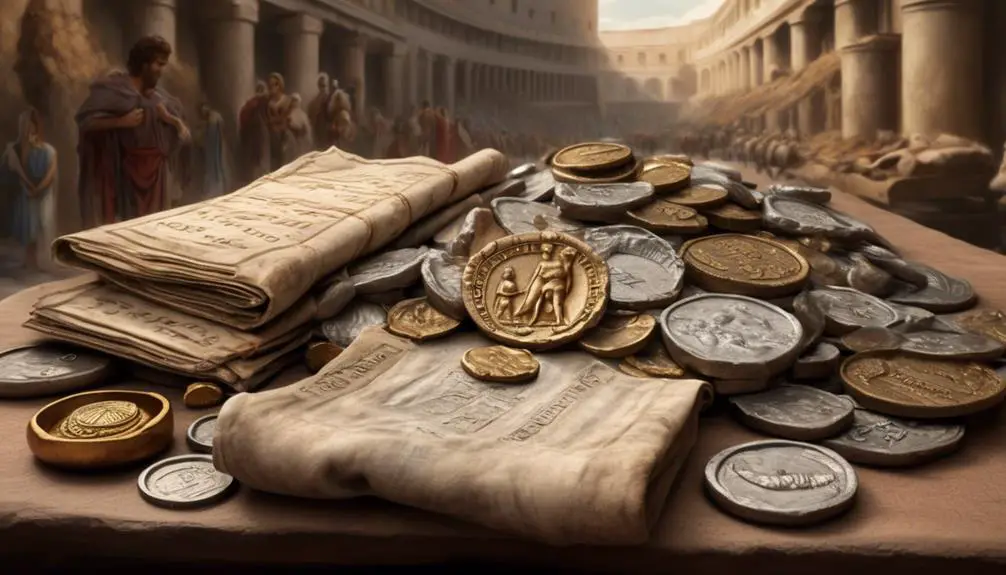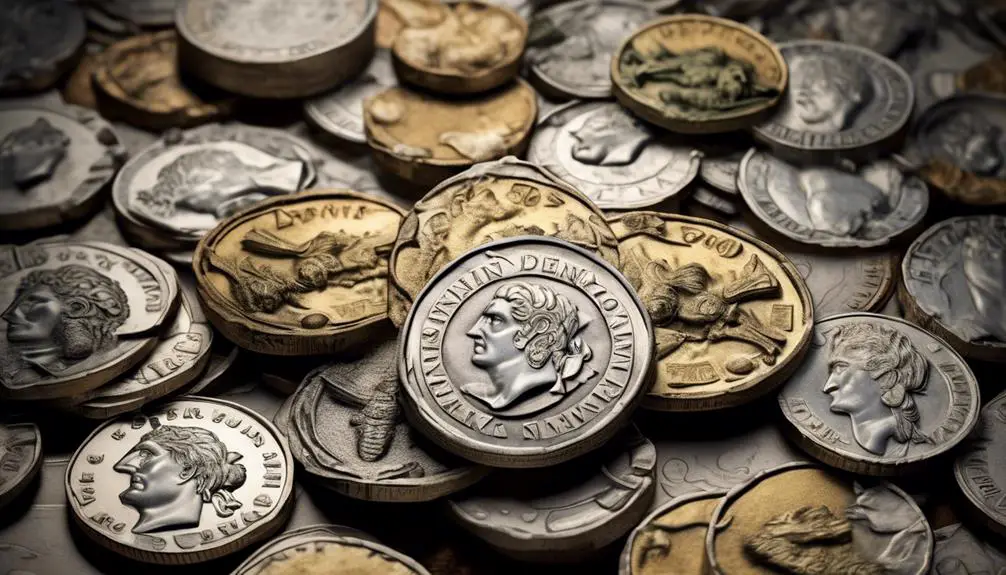Crack the ancient code of biblical currency as we delve into the worth of 300 denarii in the New Testament era.

How Much Was 300 Denarii Worth in the Bible?
Have you ever wondered about the value of currency in biblical times? When you come across passages in the Bible mentioning sums like 300 denarii, it's natural to want to understand its worth in today's terms.
The denarius was a silver coin used extensively in the Roman Empire during the New Testament times, and yes, its value can be calculated, albeit with some historical and economic detective work.
But, here's the catch: even with a monetary estimate, can we truly grasp the economic and societal implications of such a sum in biblical times? Let's explore this further, shall we?
Key Takeaways
- The denarius was a silver coin used in the Roman Empire during biblical times and was a standard day's wage for a laborer.
- The purchasing power of 300 denarii in biblical times was significant and could sustain a laborer for almost a year.
- Possessing 300 denarii indicated wealth and social influence, and it was often used in parables and stories to convey important moral and social lessons.
- Understanding the value of 300 denarii provides insights into biblical society, including the importance of wealth, social standing, and charitable acts in that culture.
Understanding the Denarius Coin

To truly grasp the value of 300 denarii in the biblical context, you first need to understand the denarius coin, which was a standard day's wage for a laborer during the Roman Empire. This coin, a small silver disc, was a crucial part of the Roman economy and played a significant role in the daily transactions of the empire. The denarius coin design varied, but it often featured the Emperor's portrait on one side and Roman symbols or deities on the other.
The Roman economy influence on the denarius was significant. The coin's value was directly tied to the economic stability of the empire. If the economy was flourishing, the denarius was worth more, if it was struggling, its value decreased. So, when you're considering the value of 300 denarii, it's essential to consider the economic context of the time.
In the biblical context, 300 denarii was a substantial amount. It was roughly equivalent to a year's wages for a laborer, as a laborer would typically earn one denarius for a day's work. That's enough to sustain a family for a year, or to purchase a considerable quantity of goods or services.
Biblical Monetary System

In understanding the biblical monetary system, you'll find it's deeply intertwined with the social, religious, and political life of the time, with the denarius coin playing a vital role in daily transactions and overall economy. This wasn't just a mere coincidence, but a strategically implemented design to ensure economic stability and seamless trade.
During this period, Roman economy influences were significant, as Rome was the ruling power. It had a sophisticated monetary system, and its currency was widely accepted in the regions it controlled, including Judaea. The denarius was a silver coin equivalent to a day's wage for a laborer, and it facilitated trade and commerce remarkably.
Ancient trading practices were also an integral part of the biblical monetary system. Instead of complex banking systems and digital transactions we're familiar with today, trade was primarily barter-based or involved direct exchange of goods and services. But with the introduction of coins like the denarius, there was a shift towards monetary exchanges, facilitating more complex and large-scale transactions.
The denarius, along with other coins like the shekel, mina, and talent, formed the backbone of the biblical monetary system. They provided a standard value for goods and services, enabling more equitable trade and ensuring that workers received fair compensation for their labor.
In a nutshell, the biblical monetary system was a blend of Roman economy influences and ancient trading practices. It was a system where coins like the denarius held significant value, influencing not just the economy, but also the social and religious aspects of life.
The Purchasing Power of Denarii

Understanding the purchasing power of denarii is crucial if you're to fully grasp the complexity and sophistication of the biblical monetary system. The denarius was a silver coin used as a standard currency in the Roman Empire, and its value was significant in economic transactions of the time.
To get a clearer picture, let's delve into some Roman economy insights. A single denarius could be enough to pay for a day's labor, or to buy a decent meal in a tavern. When you think about it, 300 denarii, then, could potentially sustain a laborer for almost an entire year. This gives you a sense of the coin's value in the Roman economy.
As for Denarii distribution, it's important to note that the majority of denarii were circulated among the wealthier classes. The average Roman citizen, especially those in the working class, didn't have a large amount of denarii at their disposal. Therefore, when the Bible mentions amounts like 300 denarii, it indicates a significant sum, hinting at the wealth or generosity of the individuals involved.
Calculating 300 Denarii's Worth

Calculating the worth of 300 denarii in today's currency isn't a straightforward task, considering the vast changes in economic systems and values over time. You have to delve deep into Roman economics and the intricacies of Biblical currencies to gain a fair understanding.
Firstly, you must remember that the denarius was the standard Roman silver coin during the time of the New Testament. The value of a denarius fluctuated throughout Roman history, but during the first century AD, it's generally agreed that one denarius equated to a day's wage for a skilled laborer or soldier.
To calculate the worth of 300 denarii, you'd essentially be calculating 300 days' wages. Now, you might be tempted to translate that directly into modern terms by taking an average daily wage for a worker today and multiplying by 300. However, this wouldn't account for the significant differences in living standards, purchasing power, and overall economic conditions between ancient Rome and the present day.
A more accurate approach would be to consider the purchasing power of 300 denarii in the first-century Roman economy. Historical records suggest that 300 denarii could afford a substantial amount of goods and services. This could include a year's supply of grain for a family, a good-quality tunic, or even a small piece of land.
Modern Equivalency of 300 Denarii

To grasp the modern equivalency of 300 denarii, you'll need to consider various factors, such as inflation, wage growth, and changes in purchasing power over the centuries. The Roman economy influence plays a crucial role in understanding this equivalency, given the currency's historical context.
The denarius was an integral part of the Roman economy, with its value intricately linked to the overall health and stability of the empire. Considering inflation, which erodes the purchasing power of money over time, you'll find that 300 denarii in the Roman period aren't directly equivalent to any fixed amount today.
However, wage growth also needs to be factored in. In the Roman era, one denarius was often the daily wage for a laborer or soldier. Thus, 300 denarii could potentially represent almost a year's income. Comparing this to modern wages can provide a rough estimate of the modern equivalency.
The Denarii's cultural significance is also worth noting. As a primary currency, it held a symbolic value reflecting the strength and prosperity of Rome. This cultural aspect is harder to quantify but is essential in understanding the perceived value of the denarius beyond its purchasing power.
Impact of 300 Denarii in Biblical Times

Delving into the significance of 300 denarii in Biblical times, you'll find it was a substantial sum, often used to illustrate important moral and social lessons. This significant sum had a profound Biblical economy impact, effectively representing a year's wage for a common laborer.
Just imagine, if you were a laborer in those times, you'd have had to toil for nearly a full year to amass 300 denarii. This perspective gives you an insight into the magnitude of this sum and the economic implications it held in that era. The fact that it was often used in parables and stories within the Bible underlines its societal value and the lessons it was utilized to convey.
The Denarii's social influence was also unquestionable. It was a measure of wealth and its possession or lack thereof could drastically affect an individual's social standing. In the Bible, the 300 denarii is mentioned in the context of charitable acts, such as the woman who anointed Jesus' feet with expensive perfume worth this amount, signifying the sacrifice and devotion involved in such an act.
In essence, the impact of 300 denarii in biblical times was both economic and social. It not only functioned as a significant economic unit but also represented social values like sacrifice, devotion, and charity. Understanding this dual role of the denarii in the biblical context enhances our comprehension of the societal and economic structures of that time.
Conclusion
In conclusion, the value of 300 denarii in biblical times held significant purchasing power. Translating this ancient currency to a modern equivalent isn't straightforward. However, considering a denarius as a day's wage, 300 denarii could represent nearly a year's salary.
Its value in the Bible, therefore, was immense, impacting decisions and actions. Understanding this helps us to grasp the economic context of biblical narratives, providing a deeper insight into these historical accounts.



Sign up